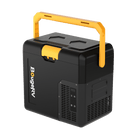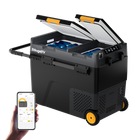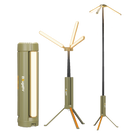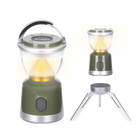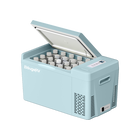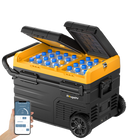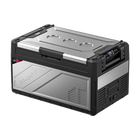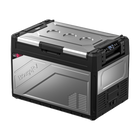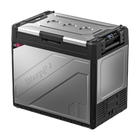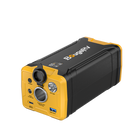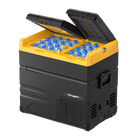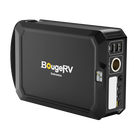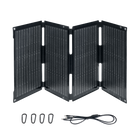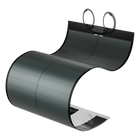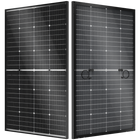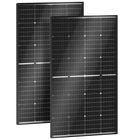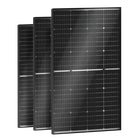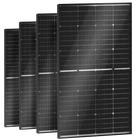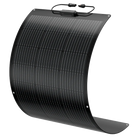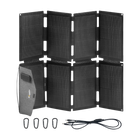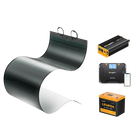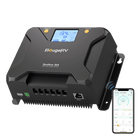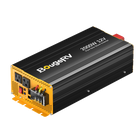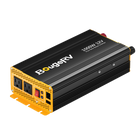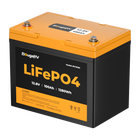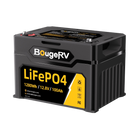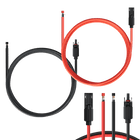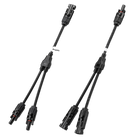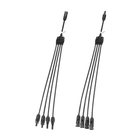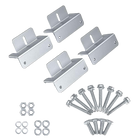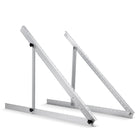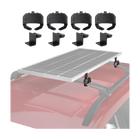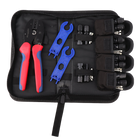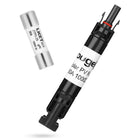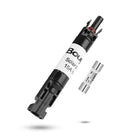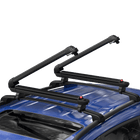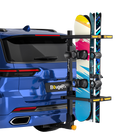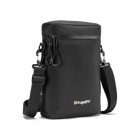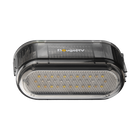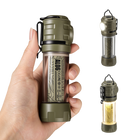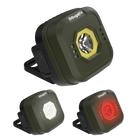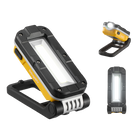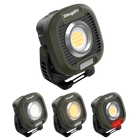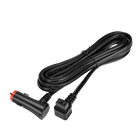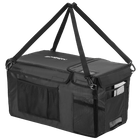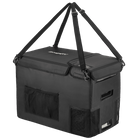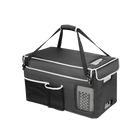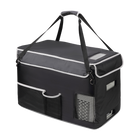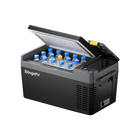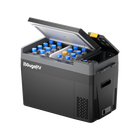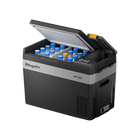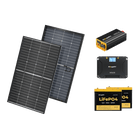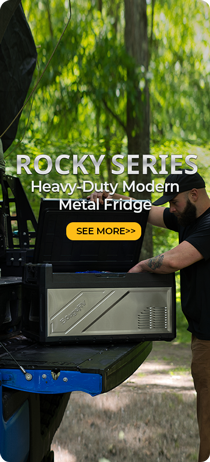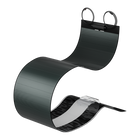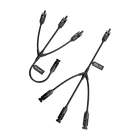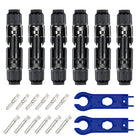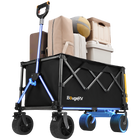What Is the Difference Between Monofacial and Bifacial Solar Panels?


Solar panels are devices that convert sunlight into electricity. They are widely used in camping, residential and commercial use, and utility-scale applications. But do you know the difference between traditional monofacial solar panels and bifacial ones?
One of the primary differences between monofacial and bifacial solar panels is that monofacial solar panels have an opaque back sheet and produce energy from only one side. In contrast, bifacial panels feature transparent back sheets and generate energy from both the front and the back sides.
In this blog post, we will delve into more differences between monofacial and bifacial solar panels, see how they work, discuss where they should be installed, and their respective pros and cons.
Read on and explore now!
How Do Monofacial Solar Panels Work?

Monofacial solar panels are the most common type of solar panels. They feature solar cells on just one side of the panel, which faces the sun to collect its rays. The solar cells are made from silicon, a semiconductor material that generates an electric current when exposed to sunlight.
The electric current is collected by metal wires and transferred to an inverter, which converts it from direct current (DC) to alternating current (AC). This AC electricity can then be used by your appliances or fed into the electrical grid.
Monofacial Meaning
The term "monofacial" means "one face" or "one side." This descriptor is applied to solar panels that have one active side facing the sun to generate electricity.
The other side of the solar panel often face the roof of the building, away from direct sunlight and covered by a protective layer of glass or plastic, which prevents dirt, dust, and moisture from damaging the solar cells.
Therefore, monofacial solar panels don’t utilize the light that is reflected or scattered by the ground, roof, or other surfaces behind them.
How Do Bifacial Solar Panels Work?

Bifacial solar panels are a newer and more advanced kind of solar panels. The bifacial solar units have solar cells on both sides of the solar panel, which can capture direct sunlight, reflected light, and diffuse light from both the front and the back.
Instead of the opaque back sheet found on monofacial solar panels, bifacial solar panels have a transparent layer of glass or plastic on both sides holding the solar cells in place, which allows light to pass through and reach the cells. Therefore, bifacial solar panels can generate more electricity than monofacial solar panels, especially in situations where there is a lot of reflected or diffuse light available.
Where Should Bifacial Solar Panels Be Installed?

- Highly reflective surfaces. Bifacial solar panels really come into their own when perched atop light-reflecting surfaces, like pearly white rooftops, snowy expanses, or sandy soils, or even elevated above the ground where snow's shimmer can play a role. These dual-sided power players seize the bonus rays thrown back from such settings, cranking up their energy harvest.
However, the bifacial solar panels are not the best suited for low-albedo surfaces like grass, soil, and dark roofs.
-
Places where has diffuse light. Bifacial solar panels are also suitable for places with a lot of diffuse light, such as cloudy days or shaded areas. They can absorb this diffuse sunlight, which is scattered in multiple directions, from both sides of the panels.
-
Residential applications. Bifacial solar modules are effective in residential applications and are often mounted at ground level. But, for most property owners contemplating a rooftop installation, monofacial solar panels may be better choices than bifacial panels.
-
Commercial or utility-scale applications. Bifacial solar panels work best in commercial or utility-scale applications, where they are installed at an elevation and angled away from the mounting ground, thereby allowing light reflection onto the back side of the panel.
When installed on the tiled racking system or ground bifacial solar mounting system, the bifacial solar panels produce more energy when the rear side of the panel can collect more reflected light. And the higher the bifacial units are tilted, the more power it deliver from the bifacial solar panels.
Do Bifacial Solar Panels Need Special Solar Mounting Structures?
Bifacial solar panels need different mounting structures than monofacial solar panels. They should be elevated above the ground or roof and tilted at a higher angle to allow enough space and light for the backside.
Furthermore, bifacial solar panels must avoid any obstruction or shading that could block light from reaching either side. So, the bifacial solar panels need mounting systems that are designed to minimize shade from the solar structures on the panels' backsides. For example, you can use solar mounts specifically designed for bifacial panels, such as PGT4 ground mount solar racking and single-axis solar tracking systems with double rows.
Conversely, don’t install your bifacial solar panels onto a single-axis solar tracking system with a single-row arrangement because the rotation axis of this type of tracker will block sunlight from hitting the rear side of the panels.
Where Should Monofacial Solar Panels Be Installed?

When it comes to monofacial solar panels, they are more suitable for locations where there is a low albedo or direct sunlight.
Monofacial solar panels can work well on flat RV roofs and rooftops, or ground-mounted systems that face south (in the northern hemisphere) or north (in the southern hemisphere). The monofacial modules don’t need to be elevated or tilted as much as bifacial solar panels, which can potentially save space and your installation costs.
Advantages of Bifacial Solar Panels Compared to Monofacial Solar Panels

Bifacial solar panels have several advantages over monofacial solar panels, such as:
-
Higher energy yield: Bifacial solar panels can produce up to 30% more electricity than monofacial solar panels under optimal conditions.
-
Studier: Bifacial solar panels are protected by tempered glass on both sides, making them more durable. The tempered glass is UV resistant and can withstand high temperatures and strong winds.
-
Longer lifespan. Bifacial solar panels have less degradation and thermal stress than monofacial solar panels because they dissipate heat better and have less potential-induced degradation (PID). (For frameless bifacial solar panels, PID occurs when electrical currents stray from their intended path, leading to corrosion of the panels. )
-
Higher flexibility. Bifacial solar panels can adapt to different orientations and environments better than monofacial solar panels because they can capture direct sunlight, reflected light, and diffuse light from multiple angles.
-
Better aesthetics. Bifacial solar panels have a sleeker and more modern look than monofacial solar panels because they do not have a visible backsheet.
Disadvantages of Bifacial Solar Panels Compared to Monofacial Solar Panels
Bifacial solar panels also have some disadvantages compared to monofacial solar panels. Now, let’s take a look at it:
- Higher cost. Bifacial solar panels are more expensive than monofacial solar panels because they need more materials, technology, and labor to make and install. For instance, a BougeRV’s 200W bifacial solar panel is priced at $249.99, while a BougeRV’s 200W monofacial solar panel has a price tag of $219.99.
As said, the bifacial units need special mounting specially designed to ensure optimal performance, which could increase installation costs.
-
Heavier. Generally, the bifacial solar panels are slightly heavier than the monofacial solar panels, because they have more layers.
-
Higher maintenance. Bifacial solar panels require more cleaning and maintenance than monofacial solar panels because they are more prone to dirt, dust, and snow accumulation on both sides.
Cost Difference Between Bifacial and Monofacial Solar Panels
Bifacial solar panels can cost about 10% to 20% more than monofacial solar panels per watt. However, this gap may narrow in the future as bifacial solar panels become more popular and affordable.
What’s more, the cost difference can be offset by the higher energy yield and longer lifespan of bifacial solar panels, contributing to a lower levelized cost of energy (LCOE) and a higher return on investment (ROI).
Bifacial vs. Monofacial Solar Panels Efficiency
When properly installed and measured from both sides, bifacial solar panels can have a higher efficiency than monofacial solar panels because they can capture more light and collect more electricity.However, bifacial solar panels have a lower efficiency than monofacial counterparts when measured from one side only.
In addition, the efficiency of bifacial solar panels is also different depending on the albedo and diffuse light conditions. The higher the albedo and diffuse light, the higher the efficiency of bifacial solar panels.
Bifacial vs. Monofacial Solar Panels Performance in Cloudy Weather
Cloudy weather reduces the amount and quality of sunlight that reaches the solar panels. It also increases the proportion of diffuse light relative to direct light. This affects the performance of both monofacial and bifacial solar panels.
Monofacial solar panels receive less light and generate less electricity in cloudy weather than in sunny weather. But they still produce some power as they can absorb some diffuse light that penetrates through the clouds.
Bifacial solar panels perform better in cloudy weather than monofacial solar panels as they can capture more diffuse light from both sides. They also benefit from the higher albedo that is caused by the reflection of light from the clouds. However, bifacial solar panels still produce less power than in sunny weather since they receive less direct light.
Are Bifacial Solar Panels Better?
Bifacial solar panels shine in certain situations, much like surfaces with high albedo, commercial or utility applications, and the ones we've discussed earlier, but monofacial solar panels might take the lead in different contexts. Before settling on the ideal solar panel for your needs, you'll need to weigh various considerations, such as:
- Your budget: Bifacial solar panels are more expensive than monofacial solar panels upfront, but they may save you money in the long run due to their higher energy yield and longer lifespan.
- Your location: Bifacial solar panels are more suitable for places where there is a high albedo or a lot of diffuse light, while monofacial solar panels are more suitable for places where there is a low albedo or a lot of direct sunlight.
- Your space: Bifacial solar panels require more space and clearance than monofacial solar panels because they need to be elevated and tilted to expose both sides to sunlight. Therefore, if you need solar panels for large solar farms, commercial or utility projects, every watt of the bifacial solar panels increases matters. For RV camping, the simpler traditional monofacial solar panels can meet your daily power needs.
However, if you finally want bifacial solar panels for RV camping and your rooftops, you can always buy compact and well-weigh bifacial solar panels at BougeRV.
- Your aesthetics: Bifacial solar panels have a more contemporary and streamlined look than monofacial solar panels because they don’t have a visible backsheet.
Final Thoughts

So far, we’ve learned that monofacial and bifacial solar panels are two different types of solar panels that have their pros and cons. Monofacial solar panels are more common, wallet-friendly, and simpler. Bifacial solar panels are newer, pricier, more complex, and more efficient, soaking up the sun's rays from both the front and back.
Picking your solar sidekick depends on your budget, location, space, and taste. Before you take the plunge, size up both contenders with a sharp eye.
Interested in more information about monofacial and bifacial solar panels? Visit BougeRV now!







